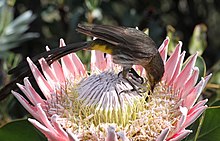Cape sugarbird
| Cape Sugarbird | |
|---|---|

| |
| male in South Africa | |
| Scientific classification | |
| Kingdom: | |
| Phylum: | |
| Class: | |
| Order: | |
| Family: | |
| Genus: | |
| Species: | P. cafer
|
| Binomial name | |
| Promerops cafer (Linnaeus, 1758)
| |
The Cape Sugarbird, Promerops cafer,[2] is one of the six bird species endemic to the Fynbos biome of the western and eastern Cape Province, South Africa.
Description
The Cape Sugarbird is a grey-brown bird that easily recognizable by a spot of yellow under its tail and the very long tail feathers present in males. The male is 34–44 cm long, and the shorter-tailed, shorter-billed, and paler breasted female 25–29 cm long. Another characteristic of the Cape Sugarbird is the sound it makes when it flies. The main flight feathers are arranged in such a way that when the bird beats its wings, a frrt-frrt sound is made with the intention of attracting females.[3]
Distribution and status

The Cape Sugarbird is distributed throughout the Cape Floral Region where there are flowering proteas and ericas. It is also found in gardens in summer when most proteas are not in flower.[3] A common species throughout its range, the Cape Sugarbird is evaluated as Least Concern on the IUCN Red List of Threatened Species.
Behaviour
Food and feeding

The Cape Sugarbird is a specialist nectar feeder when it comes to feeding off Proteaceae. Its long, sharp beak is used to reach the nectar of a variety of species of protea with its long brush-tipped tongue. The staple diet of this sugarbird is nectar, however it will also eat spiders and insects. The characteristic strong winds in the Cape may make feeding off protea heads difficult, but the Cape Sugarbird has adapted to this with the development of sharp claws.[3]
Breeding
The breeding season for the Cape Sugarbird is winter when there are ample food supplies.[3]
References
- ^ Compilers Stuart Butchart, Jonathan Ekstrom (2008). "Cape Sugarbird - BirdLife Species Factsheet". Evaluators: Jeremy Bird, Stuart Butchart. BirdLife International . Retrieved June 6, 2009.
{{cite web}}: CS1 maint: extra punctuation (link) - ^ Note: the name "cafer" is Modern Latin for Caffer, an adjective meaning South African, or of South Africa (Caffraria); which are in turn from the terms Kaffir, Caffre, or Caffer applied to certain indigenous peoples of that country (Arabic kafir, an infidel).
Aasheesh Pittie. "A dictionary of scientific bird names originating from the Indian region" (PDF). Retrieved April 27, 2009. - ^ a b c d Ian Sinclair, Phil Hockey and Warwick R. Tarboton (2002). SASOL Birds of Southern Africa. Struik Publishers. ISBN 1-86872-721-1.

